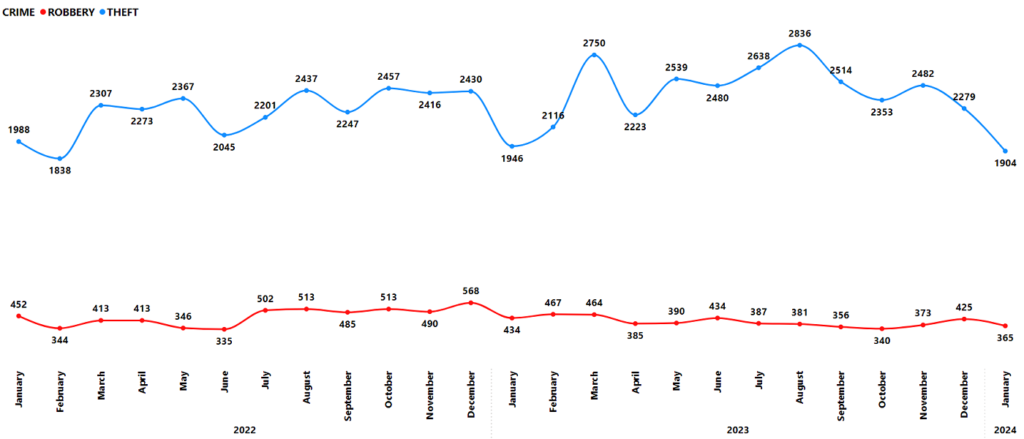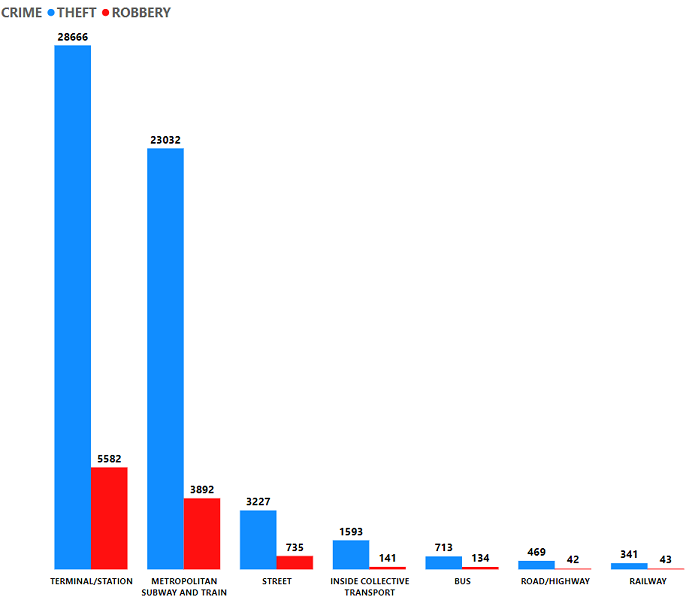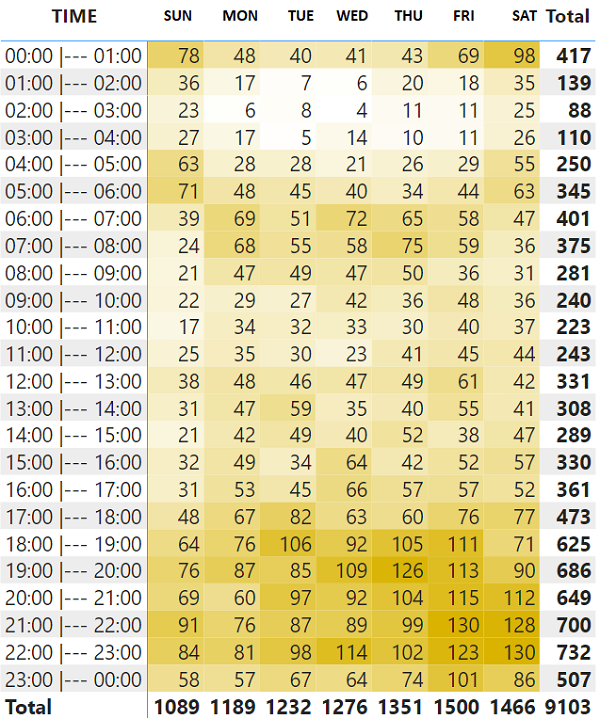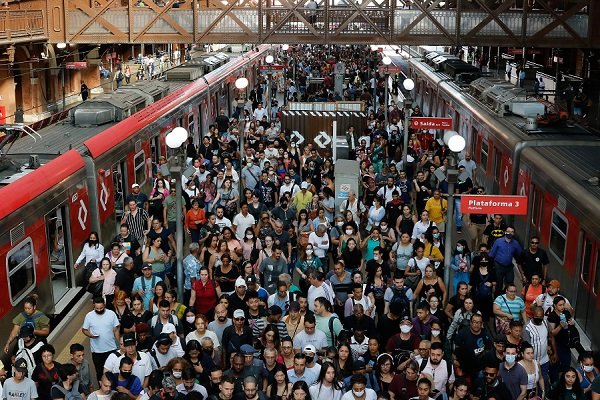SUMMARY
In large metropolises like São Paulo – the biggest city in South America –, public transport is of paramount importance for the city to operate efficiently. São Paulo’s public transport system – 1,300 bus lines, six metro lines, five train lines – is complex and faces tremendous urban mobility challenges, serving not only city residents but also the around 22 million people living in the metropolitan region.
Such a large number of people using the system attracts the attention of criminals and leads to daily incidents, despite public and private security efforts to contain risks. In order to better understand the security conditions of São Paulo’s public transport system, the INTERLIRA team made an exclusive analysis of the crime reports available in São Paulo Public Security Secretariat (SSP-SP) database.
The analysis conducted using microdata on robberies and thefts in public transport, reveals a concentration of crimes, particularly in the historic center and around transportation hubs. The study demonstrates an increase in the crime rate from 2022 to 2023, highlighting the distinction between thefts and robberies and their patterns of occurrence and timing. This data-driven investigation underscores critical locations with a high incidence of crime, illustrating the vulnerability of public transport terminals and stations. Moreover, the study emphasizes the socioeconomic repercussions of elevated crime rates, impacting urban mobility, economic productivity, and the city’s reputation.
Security in Public Transport
On Friday, 5 April, a man was arrested after trying to rob passengers inside a public transport bus in São Paulo. Images circulating on social media show the moment a vehicle stops in front of the bus and two police officers get on board, arresting the criminal. The crime occurred while the bus was traveling along Avenida Senador Vitorino Freire, in Cidade Ademar, South Zone of the city. It was the driver who asked for help as soon as he saw the presence of the Military Police.
The incident above illustrates the significant challenges in terms of urban security that the city of São Paulo faces. Incidents of robbery and theft on buses, subways, and trains not only compromise the physical and psychological integrity of passengers but also harm the population’s quality of life and perception of public security. The presence of crime on the daily routes of millions of São Paulo residents is confirmed by the distribution of crimes throughout the city — data we analyzed provided by the São Paulo Public Security Secretariat (SSP-SP).
The heat map reveals a distribution of incidents throughout the city, however, the highest incidence of robberies and theft on public transport stands out in the neighborhoods of the historic center, particularly Sé, República, Consolação, and Luz. Furthermore, there is a clear concentration of these cases in bus terminals and train and subway stations, suggesting a specific vulnerability in these areas with large passenger circulation.
Furthermore, cases of robberies and thefts on public transport showed an increase in 2023 compared to 2022. Last year, 33,992 cases were recorded, which represents an average of approximately 2,833 per month and 93 per day. This represents an increase of 5% compared to 2022, when 32,380 cases were recorded, with a monthly average of around 2,698 and 89 daily cases. In January of this year alone, the SSP-SP recorded 2,269 cases of robberies and thefts on public transport in the capital.
Difference Between Theft and Robbery
It is important to highlight the distinction between robberies and thefts. In robbery, there is the use of violence or threat, while in theft there is not. It is common in criminal studies to observe a higher incidence of thefts than robberies, as thefts expose criminals to a lower risk.
In the city of São Paulo, in 2023, 29,156 cases of theft were recorded – an average of 2,430 per month and 80 per day – representing an increase of almost 8% compared to 2022, when 27,006 cases were recorded. On the other hand, concerning robberies, 4,836 cases were registered in 2023 – an average of 403 per month and 13 per day – a 10% drop compared to 2022, when 5,374 cases were registered.

Patterns and Schedules
Another significant difference is in the times these crimes occur. Thefts mainly occur during the peak hours of public transport, in the morning and in the late afternoon. The first occurs from 6:00 to 9:00, when most workers are on their way to work, and the second from 17:00 to 19:00, when they leave work. This distribution is not surprising, as it is directly related to the greater number of passengers. Theft is favored on crowded buses, where the criminal can remove a wallet from a bag or pocket without being noticed and quickly blend into the crowd.

On the other hand, robberies do not follow the patterns of increasing passenger numbers. They are mainly concentrated between 18:00 and 23:00 and are more frequent on empty buses, close to the end of the line, allowing criminals to quickly escape without being caught.
Critical Points: Locations with the Highest Incidence
When analyzing the distribution of criminal incidents in different locations, it becomes evident that public transport terminals and stations emerge as the most susceptible places to these events, representing almost half (49.89%) of all registered cases, totaling 34,248 between January 2022 and January 2024. This annual average of 17,124 incidents, with 1,712 per month and 71 per day, reflects the crowding of people at these transfer points, which provides opportunities to commit criminal activities.
Furthermore, it is noteworthy that the subway and trains also present a significant proportion of incidents, corresponding to 39.22% of the total, with 26,924 cases recorded in the same period. This translates into an annual average of 8,975 cases, with 1,077 per month and 53 per day.

São Paulo Historic Center
With the increase in crime in the center of São Paulo, a type of theft that has become common is stealing passengers’ cell phones inside buses through the window. This strategy, although practiced for years, has become more frequent with the problems related to “Cracolândia”, which for the past two years has become “nomad”, moving every day to a new street in the city central area. Usually carried out in pairs, as shown in the video below, one of the thieves serves as a support for the other, who hangs out of the window to steal phones from distracted people.
The images were recorded in João Mendes Square, close to the Cathedral and the Court of Justice, an area that should be even safer. However, the passenger noticed something suspicious and took cover, frustrating the actions of the criminals, who fled after their attempt failed.
In the region of the historic center of São Paulo alone, 24,971 cases of robberies and thefts on public transport were recorded between January 2022 and January 2024. Of these, 3,913 were cases of robbery and 21,058 were cases of theft. Of the five neighborhoods with the highest incidence, four are in the center of São Paulo: Centro, Bom Retiro, Brás, and República.
It is crucial to understand the factors that contribute to this high concentration of crimes in the historic center of São Paulo. Firstly, population density and intense commercial activity play a significant role. The historic center is visited by a large number of people throughout the day, including workers, tourists, and residents, creating an environment conducive to the occurrence of crimes.
Furthermore, the public transport infrastructure in the area is highly busy, with a complex network of terminals, metro stations, and bus stops. These locations serve as points of convergence for thousands of passengers daily, increasing opportunities for criminal activity.


Another factor to be considered is the presence of the “Cracolândia”, as previously mentioned, a known region where drug users go to buy and consume low-cost drugs in the central region of São Paulo. Finally, the presence of tourist attractions and places of great cultural activity can also attract individuals with criminal intentions, taking advantage of the presence of unsuspecting visitors and the hustle and bustle characteristic of these areas.
Rate per 100,000 Inhabitants
According to the 2022 census by the Brazilian Institute of Geography and Statistics, the city of São Paulo has a population of 11,451,999 inhabitants. As a result, the rate of robberies and thefts on public transport reached 297.1 cases per 100,000 inhabitants in 2023, revealing an alarming situation. This high crime rate brings with it a series of concerns and negative consequences for the city.
Firstly, this high number represents a serious threat to the sense of security of citizens who use public transport daily. The perception of insecurity can result in a drastic decrease in the use of this essential service, affecting not only urban mobility, but also access to employment opportunities, education, and health services.
Furthermore, robberies and thefts on public transport not only put the physical integrity of passengers at risk but also have a profound psychological impact, generating widespread fear and anxiety among the population. The feeling of vulnerability can lead people to avoid public transport, limiting their activities and affecting their quality of life.
The social and economic costs associated with this high crime rate are significant. The increase in crime on public transport implies additional costs for security authorities, who need to invest in prevention and repression measures. Additionally, lost productivity resulting from delays and interruptions caused by criminal incidents negatively impacts the city’s economy.
These crimes also affect São Paulo’s reputation and attractiveness as a tourist destination and business center, harming the city’s economic development and image both nationally and internationally.




